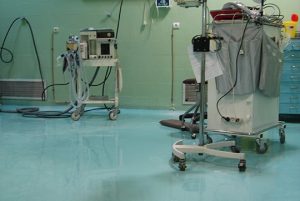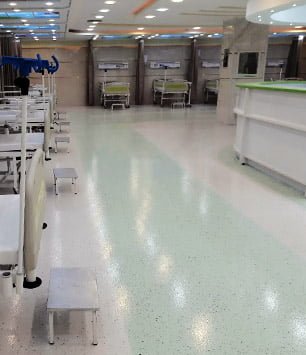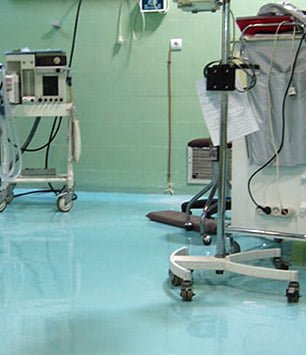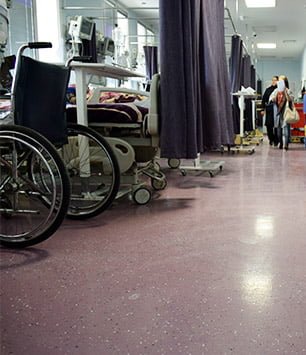Description
What is antibacterial flooring? According to the World Health Organization (WHO), the rate of hospital infections varies between 5 and 10% in different countries. Taking into account the statistics announced by the Disease Management Center of the Ministry of Health, according to which about 6 million patients are admitted to 800 hospitals in the country, the importance of controlling hospital infections to prevent the resulting damages can be understood.
One of the ways to reduce the possibility of the spread of hospital infection is to choose antibacterial hospital flooring. By choosing integrated and seamless flooring, the penetration of liquids and pollution under the flooring will also be prevented. These floors are equipped with coatings that resist any chemicals, disinfectants, and liquids. This is why the maintenance and cleaning costs of this type of flooring are much lower than other flooring available in the market for use as hospital flooring. This issue is significantly less in the case of hospital resin flooring such as epoxy flooring due to the lack of glue, the absence of seams, and the elimination of ninety-degree angles at the joint between the floor and the wall.
Hospital Antibacterial Flooring
To keep patients safe from infections or diseases, hospitals and other healthcare centers need sanitary floors. Also, hospital managers show high sensitivity in choosing sanitary and antibacterial hospital flooring due to the knowledge of the irreparable costs of hospital infection.
Hospital flooring should be anti-bacterial or anti-bacterial, non-slip, durable, easy to clean, and comply with other environmental considerations. In addition to the inherent characteristics of hospital flooring, a regular program for cleaning and disinfecting the flooring should be prepared and implemented. Although the choice of antibacterial flooring prevents the growth of bacteria to a significant extent, the role of regular daily cleaning cannot be ignored.
Now that we have learned about the importance of choosing sanitary flooring for hospitals, in this section we will examine the features of Antibacterial Epoxy Flooring, which has made its use as a hospital flooring a better choice.
Features of Antibacterial Flooring:
1. The most important feature of hospital flooring (antibacterial flooring) is the ability to remove microorganisms in contact with the flooring surface. This characteristic of the floor is called antibacterial. Due to the use of antibacterial substances in the formulation, the Antibacterial Epoxy floor prevents the growth of pathogenic agents (such as fungi, bacteria, algae, and generally pathogenic microorganisms) and in Presence removes them from the surface.
2. Absence of a ninety-degree angle in the corners of the wall, absence of seams and complete integrity of the surface (similar to antibacterial epoxy flooring), absence of space between the flooring and the underlying surface (usually concrete or mosaic). This space is created by gluing roll flooring and hospital tiles on the floor. This space is usually susceptible to water infiltration caused by washing the roll flooring under it, which not only provides a suitable environment for the growth of pathogenic microorganisms but also with the dissolution of the roll flooring adhesive, the flooring will be separated from the floor over time.
3. Antibacterial epoxy flooring is non-absorbent. In other words, body fluids, disinfectants, and other liquids that somehow come into contact with the flooring will not penetrate deep into it, and by wiping the liquids from the surface of the flooring, no trace of it will remain on the surface.
4. Epoxy antibacterial flooring is integrated and seamless. The absence of seams in these floorings eliminates the problems caused by the accumulation of dust and pollution in possible seams (such as tile and ceramic seams) and while preventing the growth and appearance of pathogens in these places, it also simplifies the cleaning of the flooring.
5. Due to its thermoset chemical structure, antibacterial resin flooring has very high mechanical properties and long service life and has excellent chemical resistance against disinfectants.
6. Antibacterial flooring, along with proper slip resistance (which prevents injuries caused by personnel and patients slipping), facilitates the movement of wheeled devices such as wheelchairs and stretchers due to its smooth and seamless surface.
 |
 |
Examples of projects implemented with BASA Polymer Antibacterial flooring material
The price of Hospital Antibacterial Flooring
Besapolymer hospital antibacterial floors, while creating a seamless and seamless surface, removing 90-degree angles in the corners, and creating a new building floor (no space between the floor and the subfloor), excellent chemical resistance against disinfectants and antibacterial properties are the right choice of the surface. They are among the types of hospital flooring.
Besapolymer antibacterial hospital flooring has a bacterial culture test certificate, and based on the results of this test, 99.9% of the bacteria cultured on the floor surface have disappeared.
In general, various factors such as the required thickness of the flooring, the needs of the employer, the chosen design, whether it is Antistatic or not, etc., are effective in the cost of antibacterial resin flooring. The best way to know the exact price of antibacterial flooring is to contact and get advice from the flooring manufacturer.





Reviews
There are no reviews yet.